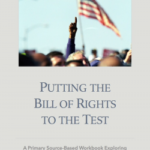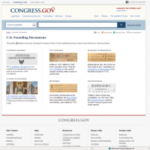Looking for a quick and easy way to read the primary sources mentioned in the We the People: The Citizen & the Constitution textbook? ConSource has created correlations linking lessons of the We the People text with primary sources available at ConSource.org. The correlations of the We the People text are listed by unit and lesson. Clicking on the link takes you to the full text of the primary source on the ConSource website.
Primary Source Documents Correlated with “We the People: The Citizen & the Constitution” Middle School Textbook
Looking for a quick and easy way to read the primary sources mentioned in the We the People: The Citizen & the Constitution textbook? ConSource has created correlations linking lessons of the We the People text with primary sources available at ConSource.org. The correlations of the We the People text are listed by unit and lesson. Clicking on the link takes you to the full text of the primary source on the ConSource website.
3 Must-Have Supreme Court Nomination Documents
“3 Must-Have Supreme Court Nomination Documents” looks at President Ronald Reagan’s appointment of Supreme Court Justice Antonin Scalia in 1986. Primary Source A outlines the suggested qualities of an ideal candidate for President Reagan to nominate to the Supreme Court. Primary Source B provides a Memo to the President from Peter J.
Wallison, Counsel to the President, in which Wallison provides background information with a few potential questions for both Justice Rehnquist and Judge Scalia. Primary Source C is a transcript from President Reagan’s August 9, 1986, Radio Talk on the appointment of the Supreme Court Justices. Each of these documents showcase the amount of thought and consideration the president must take when nominating a Supreme Court Justice.
Freedom Summer 1964
Freedom Summer is a digital learning tool (available on the web or as an app) for teachers and students that explores key events surrounding this time in America’s history and the impact of the civil rights movement on civil rights legislation. Players predict the outcomes of civil and congressional actions and discover how the events are intertwined. Students have the opportunity to view informative intro and outro videos and analyze 20 primary sources depicting images of civil rights events. Analysis of a variety of primary sources and supplemental information leads students to identify varying perspectives and potential outcomes. Freedom Summer is formatted for all types of computers and mobile devices, including Chromebooks, and can be found on the website or in any app store for download.
LGBTQ Activism and Contributions Primary Source Set
The lives, freedom struggles, and social and cultural contributions of lesbian, gay, bisexual, transgender, and queer (LGBTQ) people make up a rich part of the history of the United States, and primary sources from the Library of Congress provide valuable opportunities to explore individuals, movements, and events from the nation’s LGBTQ history.
Indian Boarding Schools Primary Source Set
Through photographs, letters, reports, interviews, and other primary documents, students explore the forced acculturation of American Indians through government-run boarding schools.
Putting the Bill of Rights to the Test

This primary source-based workbook (as PDF or eBook/ePub) helps students explore some of the protections found in the Bill of Rights and how they’ve been tested throughout U.S. history. Each chapter includes background information, guiding questions, analysis questions, primary sources, and discussion questions. Concepts include freedom of religion, speech and press; the right to assemble, petition, bear arms, and have counsel; search and seizure; due process; and cruel and unusual punishment.
United States Founding Documents
Statue of Freedom and Philip Reid Primary Source Lesson
This primary source exploration focuses on the statue atop the Dome of the U.S. Capitol. More than 19 feet tall and cast in bronze, its name is Freedom. American artist Thomas Crawford sculpted Freedom from plaster at his studio in Rome, Italy. Crawford created three designs.
Black History Month Lesson Plans on Nonviolence
The power of nonviolent actions and attitudes as a means to resist oppression and spur reforms is a recurring feature of democratic and democratizing societies. The School Violence Prevention Demonstration Program presents educators with lesson plans that explore the use of nonviolence in history, paying particular attention to the civil rights movement and African American history. Six lessons address: the 1963 Children’s March; the concept of nonviolence using primary sources and stories of participants in the civil rights movement; the power of nonviolence; the story of Rosa Parks; citizenship schools; how music can be used to achieve social and political change.
